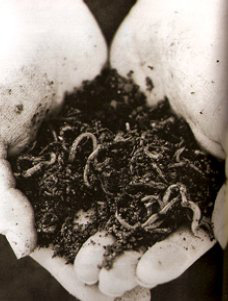Earthworms and Bacteria Enjoy a Symbiotic Relationship with Rockdust
The Eco-Logic of Vermiculture
By Uday Bhawalker
Each organism has a role and occupies a niche. In fact, shown by the Russian ecologist, Gause, about 30 years ago that each niche has only one organism with its specific food. If another organism is introduced, it either gets wiped out or creates its own micro-niche by living symbiotically with the first, for example, by using the waste matter of the first organism as food.
Ecology of worm bins
Let us use eco-logic to understand the ecology (ecology: the relationship between organisms and their environment) of worm bins. Worm bins are meant for bioprocessing of organic wastes. In a worm bin organics are consumed by diverse organisms and those who are fast out-compete those who are slow.
It is a fact of life that small organisms such as bacteria are voracious eaters. Their appetite could be 20,000 times that of a man when compared on equal weight basis. Next in size come the fungi. Fungi have smaller appetites since they have about 100 times larger body size and anaerobic bacteria have poor appetites due to the unavailability of oxygen. All the other large organisms (worms and humans included) have smaller appetites relative to their weight.
What then prevents the bacteria from out-competing the larger animals for the available food? If bacteria, fungi, and worms are competing for food in a worm bin, obviously bacteria would win due to their speed of food consumption and growth. Given ideal conditions of temperature, moisture, pH and aeration, bacteria can double their population in 20 minutes, fungi in 3-4 hours, while worms take days. This speed of reproduction coupled with their voracious appetite mentioned above make beneficial bacteria the clear winner if conditions are suitable for them.
Beneficial bacteria in the composting process prefer a neutral pH and about 50% moisture which allows good aeration in the mass of decomposing organics. Fungi come into play only when bacteria slow down due to low moisture or acidity. Stale bread, for example, would develop fungal growth when the moisture level is too low for bacteria. Composting starts with bacteria but it will soon change over to fungal mode due to the acidity produced by the bacteria. If this acidity (normally produced in the process of decomposition) is coupled with higher moisture content (above 75%) the process becomes suitable for redworms and they will become the dominant processors.
Thus, redworms have a role when the pH becomes acidic and bacteria slow down their activity. It is found that redworms grow faster and eat fastest when the pH is around 5. Redworms consume the acidic food and produce alkaline excretions, thus shifting the pH to neutral, which is more suitable for bacteria. Once the wastes that are creating the acidity have been consumed by the redworms their population will diminish as their job is completed and the environment will be less suitable for them.
The role of burrowing earthworms on the other hand is one which is played symbiotically with beneficial bacteria, as they both prefer the conditions of neutral pH and 50% moisture. And, since in its role as a soil processor, the earthworm ingests these bacteria, the gut of the earthworm is a perfect natural bioreactor which provides an ideal breeding ground for these beneficial aerobic bacteria while at the same time destroying anaerobic bacteria, fungi and pathogens.
Although this process utilizing burrowing earthworms can be carried out most simply and efficiently directly on the soil, it is also possible to have a worm bin with earthworms in it as long as there is 3-4 inches of soil as bedding and a neutral pH and a 50% moisture content are maintained. A neutral pH is maintained in part through the use of rock dust, which is added each time food wastes are introduced to the system.
Nature’s warning signals
When organics are processed around neutral pH and create no odor, the process is hygienic. Bacteria that grow at neutral pH are mostly beneficial soil bacteria that produce several growth factors that are needed by plants. Safe processing of organics takes place without emitting signals such as odor and pests.
When the pH becomes too acidic or alkaline or the organics become anaerobic due to a shortage of oxygen, the organics may be processed by pathogens and toxin-producing bacteria. This amounts to a kind of biological fire (biofire). Such biofire is sensed, alarmed and remediated by pests such as rats, flies, etc. They provide us with a visible sign that warns of an unhealthy situation.
So if your worm bin attracts pests, they are probably involved in a fire-fighting service. We can help them by sprinkling lime or fine rock dust on the composting mass, which will return the pH to neutral and encourage speedier processing of the organics into excellent pant food. When the job is being well done, it displays no warning signals.
Reprinted from Worm Digest, Winter 1995.
Support us on Patreon
Thank you for joining us today! Please become a member of RTE and support us on Patreon. Unlike many larger organizations, we work with a team of determined and passionate volunteers to get our message out. We aim to continue to increase the awareness of remineralization to initiate projects across the globe that remineralize soils, grow nutrient dense food, regenerate our forests’ and stabilize the climate – with your help! If you can, please support us on a monthly basis from just $2, rest assured that you are making a big impact every single month in support of our mission. Thank you!








Gamini Weerasinghe
May 12, 2017 (4:06 am)
I am from Sri Lanka and would like to know where I could purchase Eisenia foetida worms
Joanna Campe
September 27, 2017 (7:49 pm)
We do not have this info, but hopefully you can track it down!